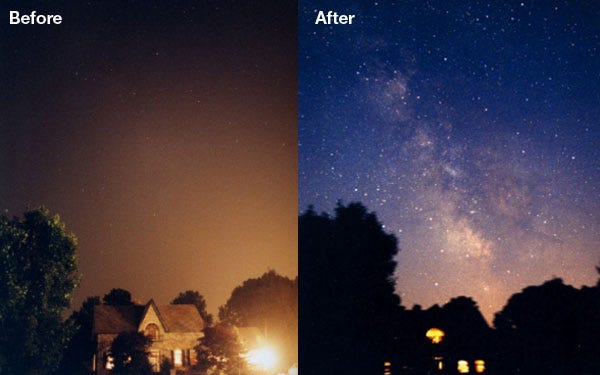Star Light, Star Bright
Dim lights brighten the skies, home exterior lighting, and invitation to virtual Dark Sky Conference this November
Nature amazes. How is it that when we reduce artificial light, nature becomes brighter?
This November, the International Dark Sky Association (IDA) will be hosting their annual virtual conference, Under One Sky. This event is free, but requires registration. I will be attending and sharing insights and recaps. You are also welcome to come! Here's the link where you can sign up for free:
Join the International Dark-Sky Association for Under One Sky 2022 – a 24-hour virtual event that will leave you feeling inspired and empowered to combat light pollution in your community. You’ll hear from experts and storytellers in the dark sky movement, connect with passionate individuals from IDA’s global network, and learn about hands-on activities and tools that you can use to protect the night through engagement workshops.
The conference will kick off on November 11 with a global session, and then will have regional sessions. I'll be attending the PST sessions and those relating to human health and community organization.
One of the things I love about IDA is their practical approach to night sky preservation. They have two programs in particular that are great for everyday people.
The first is their home certification. Here's the link where you can take steps and certify your own home.
Do you know if your home lighting is community and night sky friendly? Follow the steps below to find out. Most people will find that a few simple changes can lead to lighting that is both beautiful and functional, without contributing to excessive light pollution.
The other, related, is their lighting fixture seal of approval. This marks good light fixtures for private and commercial use. Light shining upwards it is not useful and contributes to skyglow. Home Depot and several other lighting companies have partnered with them.
IDA’s Fixture Seal of Approval program certifies outdoor lighting fixtures as being Dark Sky Friendly, meaning that they minimize glare while reducing light trespass and skyglow. All products approved in the program are required to be fully shielded and to minimize the amount of blue light in the nighttime environment.
Wildlife, health, energy, heritage, and safety inform this work. If this resonates with you, here's where you can find your local chapter: Find an IDA Chapter Near You.
For those of you in Oregon, here's the direct link to our chapter: Dark Sky Oregon. Our chapter is leading the way in sky glow measurement and has some amazing technical work available on their website. One example is this map showing Oregon’s skyglow at present:
If you like maps like this, visit Dark Sky Oregon for the slideshow on the homepage.
Until November!
I'll share more about the Under One Sky conference in November. In the meantime, here are my notes from last year's conference with links to replays:








